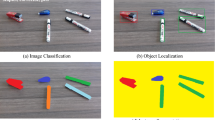Abstract
This paper proposes a sampling based hierarchical approach for solving the computational demands of the spectral clustering methods when applied to the problem of image segmentation. The authors first define the distance between a pixel and a cluster, and then derive a new theorem to estimate the number of samples needed for clustering. Finally, by introducing a scale parameter into the similarity function, a novel spectral clustering based image segmentation method has been developed. An important characteristic of the approach is that in the course of image segmentation one needs not only to tune the scale parameter to merge the small size clusters or split the large size clusters but also take samples from the data set at the different scales. The multiscale and stochastic nature makes it feasible to apply the method to very large grouping problem. In addition, it also makes the segmentation compute in time that is linear in the size of the image. The experimental results on various synthetic and real world images show the effectiveness of the approach.
Similar content being viewed by others
References
Kanungo T, Mount D M, Netanyahu N S, et al. An efficient k-means clustering algorithm: analysis and implementation. IEEE Trans Patt Anal Mach Intel, 2002, 24(7): 881–892
Chen C W, Luo J, Parker K J. Image segmentation via adaptive k-mean clustering and knowledge-based morphological operations with biomedical applications. IEEE Trans Image Proce, 1998, 7(12): 1673–1683
Shen S, Sandham W, Granat M, et al. MRI fuzzy segmentation of brain tissue using neighborhood attraction with neural-network optimization. IEEE Trans Inf Tech Biomed, 2005, 9(3): 459–467
Zhang Y, Brady M, Smith S. Segmentation of brain MR images through a hidden Markov random field model and the expectation-maximization algorithm. IEEE Trans Medical Imag, 2001, 20(1): 45–57
Pal S K, Mitra P. Multispectral image segmentation using the rough-set-initialized EM algorithm. IEEE Trans Geosci Remote Sens, 2002, 40(11): 2495–2501
Yin H, Allinson N M. Unsupervised segmentation of textured images using a hierarchical neural structure. Elect Lett, 1994, 30(22): 1842–1843
Meila M, Xu L. Multiway cuts and spectral clustering. University of Washington Technical Report 442. 2003
Shi J, Malik J. Motion segmentation and tracking using normalized cuts. University of California at Berkeley Technical report UCB/CSD-97-962. 1997
Yu S X, Shi J. Segmentation given partial grouping constrains. IEEE Trans Patt Anal Mach Intel, 2004, 26(2): 173–183
Shi J, Malik J. Normalized cuts and image segmentation. IEEE Trans Patt Anal Mach Intel, 2000, 22(8): 888–905
Fowlkes C, Belongie S, Chung F, et al. Spectral grouping using the Nyström method. IEEE Trans Patt Anal Mach Intel, 2004, 26(2): 214–225
Keuchel J, Schnörr C. Efficient graph cuts for unsupervised image segmentation using probabilistic sampling and SVD-based approximation. In 3rd International Workshop on Statistical and Computational Theories of Vision at ICCV, Nice (France), October 12, 2003
Sun J. Matrix Perturbation Analysis (in Chinese). 2nd ed. Beijing: Science Press, 2001. 168–169
Tian Z, Li X, Ju Y. Spectral clustering based on matrix perturbation theory. Sci China Ser F-Inf Sci, 2007, 50(1): 63–81
Bach R, Jordan M I. Learning spectral clustering. University of California at Berkeley Technical report UCB/CSD-03-1249. 2003
Ding C H Q, He X, Zha H, et al. A min-max cut algorithm for graph partitioning and data clustering. In: Cercone N, Lin T Y, Wu X, eds. ICDM 2001. Los Alamitos, California: IEEE Computer Society, 2001. 107–114
Martin D, Fowlkes C, Tal D, et al. A database of human segmented natural images and its application to evaluating segmentation algorithms and measuring ecological statistics. In: Werner B, ed. Proceedings of the International Conference on Computer Vision. Los Alamitos, California: IEEE Society Press, 2001. 416–423
Author information
Authors and Affiliations
Corresponding author
Additional information
Supported by the National Natural Science Foundation of China (Grant No. 60375003) and the Aeronautical Science Foundation of China (Grant No. 03153059)
Rights and permissions
About this article
Cite this article
Li, X., Tian, Z. Multiscale stochastic hierarchical image segmentation by spectral clustering. SCI CHINA SER F 50, 198–211 (2007). https://doi.org/10.1007/s11432-007-0016-7
Received:
Accepted:
Issue Date:
DOI: https://doi.org/10.1007/s11432-007-0016-7




